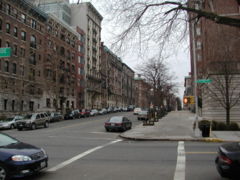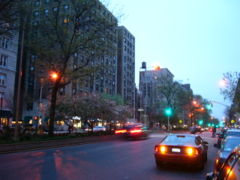Difference between revisions of "Morningside Heights"
Absentminded (talk | contribs) m |
|||
| (5 intermediate revisions by 4 users not shown) | |||
| Line 4: | Line 4: | ||
[[Image:MHview2.jpg|thumb|240px|From [[w:Image:Broadway_night3.jpg|here]].]] | [[Image:MHview2.jpg|thumb|240px|From [[w:Image:Broadway_night3.jpg|here]].]] | ||
| − | Columbia's neighborhood. It is a distinct neighborhood located between the [[Upper West Side]] and [[Harlem]] neighborhoods of [[Manhattan]]. It is roughly bounded by 110th | + | '''Morningside Heights''' is Columbia's neighborhood. It is a distinct neighborhood located between the [[Upper West Side]] and [[Harlem]] neighborhoods of [[Manhattan]]. It is roughly bounded by [[110th Street]], 123rd Street, [[Riverside Drive]], and [[Morningside Drive]]. |
Morningside Heights is home to several academic institutions, and is therefore sometimes referred to as the "Academic Acropolis". The most prominent campus is Columbia's [[Morningside Heights campus]]. | Morningside Heights is home to several academic institutions, and is therefore sometimes referred to as the "Academic Acropolis". The most prominent campus is Columbia's [[Morningside Heights campus]]. | ||
| + | |||
| + | == History == | ||
| + | |||
| + | ===1950s === | ||
| + | In the post-war years, [[w:White flight|white flight]] from New York City resulted in changing characteristics of the Morningside Heights neighborhood. Most notably, landlords converted apartment buildings in the neighborhood into Single Room Occupancy (SRO) 'hotels'. The changes in the neighborhood and poor living conditions of the SROs prompted the [[Spectator]] to run an 18-part series in [[1958]] titled "Slums on Morningside" authored by then-news editor, and future [[w:Post-Keynesian economics|post-keynsian]] economist [[w:Alfred Eichner|Alfred Eichner]].<ref>http://spectatorarchive.library.columbia.edu/cgi-bin/columbia?a=d&d=cs19580210-01.2.2 - 1st part. Keep clicking through to the next issues to see the rest.</ref> Faculty decried the quality of housing and public schools in the neighborhood.<ref>http://spectatorarchive.library.columbia.edu/cgi-bin/columbia?a=d&d=cs19570222-01.2.17</ref> | ||
== External links == | == External links == | ||
| − | * | + | * [http://www.columbiauniversitycampus.com/ Columbia University Campus] |
* [http://groups.yahoo.com/group/morningsideheights/ Morningside Heights Neighborhood Discussion Site] | * [http://groups.yahoo.com/group/morningsideheights/ Morningside Heights Neighborhood Discussion Site] | ||
| − | [[Category:Morningside Heights]] | + | == See also == |
| + | * Dolkart, Andrew. "Morningside Heights: A history of its architecture and development." Columbia University Press (1998). | ||
| + | |||
| + | ==References== | ||
| + | <references/> | ||
| + | |||
| + | [[Category:Morningside Heights|*]] | ||
Latest revision as of 22:11, 31 May 2013


Morningside Heights is Columbia's neighborhood. It is a distinct neighborhood located between the Upper West Side and Harlem neighborhoods of Manhattan. It is roughly bounded by 110th Street, 123rd Street, Riverside Drive, and Morningside Drive.
Morningside Heights is home to several academic institutions, and is therefore sometimes referred to as the "Academic Acropolis". The most prominent campus is Columbia's Morningside Heights campus.
History
1950s
In the post-war years, white flight from New York City resulted in changing characteristics of the Morningside Heights neighborhood. Most notably, landlords converted apartment buildings in the neighborhood into Single Room Occupancy (SRO) 'hotels'. The changes in the neighborhood and poor living conditions of the SROs prompted the Spectator to run an 18-part series in 1958 titled "Slums on Morningside" authored by then-news editor, and future post-keynsian economist Alfred Eichner.[1] Faculty decried the quality of housing and public schools in the neighborhood.[2]
External links
See also
- Dolkart, Andrew. "Morningside Heights: A history of its architecture and development." Columbia University Press (1998).
References
- ↑ http://spectatorarchive.library.columbia.edu/cgi-bin/columbia?a=d&d=cs19580210-01.2.2 - 1st part. Keep clicking through to the next issues to see the rest.
- ↑ http://spectatorarchive.library.columbia.edu/cgi-bin/columbia?a=d&d=cs19570222-01.2.17